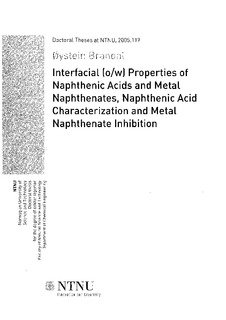| dc.contributor.author | Brandal, Øystein | nb_NO |
| dc.date.accessioned | 2014-12-19T13:23:00Z | |
| dc.date.available | 2014-12-19T13:23:00Z | |
| dc.date.created | 2005-10-27 | nb_NO |
| dc.date.issued | 2005 | nb_NO |
| dc.identifier | 125766 | nb_NO |
| dc.identifier.isbn | 82-471-7119-8 | nb_NO |
| dc.identifier.uri | http://hdl.handle.net/11250/248115 | |
| dc.description.abstract | Deposition of metal naphthenates in process facilities is becoming a huge problem for petroleum companies producing highly acidic crudes. In this thesis, the main focus has been towards the oil-water (o/w) interfacial properties of naphthenic acids and their ability to react with different divalent cations across the interface to form metal naphthenates.
The pendant drop technique was utilized to determine dynamic interfacial tensions (IFT) between model oil containing naphthenic acid, synthetic as well as indigenous acid mixtures, and pH adjusted water upon addition of different divalent cations. Changes in IFT caused by the divalent cations were correlated to reaction mechanisms by considering two reaction steps with subsequent binding of acid monomers to the divalent cation. The results were discussed in light of degree of cation hydration and naphthenic acid conformation, which affect the interfacial conditions and thus the rate of formation of 2:1 complexes of acid and cations. Moreover, addition of non-ionic oil-soluble surfactants used as basis compounds in naphthenate inhibitors was found to hinder a completion of the reaction through interfacial dilution of the acid monomers.
Formation and stability of metal naphthenate films at o/w interfaces were studied by means of Langmuir technique with a trough designed for liquid-liquid systems. The effects of different naphthenic acids, divalent cations, and pH of the subphase were investigated. The results were correlated to acid structure, cation hydration, and degree of dissociation, which all affect the film stability against compression.
Naphthenic acids acquired from a metal naphthenate deposit were characterized by different spectroscopic techniques. The sample was found to consist of a narrow family of 4-protic naphthenic acids with molecular weights around 1230 g/mol. These acids were found to be very o/w interfacially active compared to normal crude acids, and to form Langmuir monolayers with stability depending on the aqueous pH. At high pH, addition of Ca2+ increased the film stability due to formation of calcium naphthenate at the surface.
A new experimental setup based on near infrared spectroscopy was used to monitor the formation, growth, and inhibition of calcium naphthenate particles in o/w systems. This method was found to be suitable for studies of particle formation rate and growth qualitatively under different experimental conditions. | nb_NO |
| dc.language | eng | nb_NO |
| dc.publisher | Fakultet for naturvitenskap og teknologi | nb_NO |
| dc.relation.ispartofseries | Doktoravhandlinger ved NTNU, 1503-8181; 2005:119 | nb_NO |
| dc.relation.haspart | Brandal, Ø; Sjöblom, J; Øye, G. Interfacial Behavior of Naphthenic Acids and Multivalent Cations in Systems with Oil and Water. I. A Pendant Drop Study of Interactions Between n-Dodecyl Benzoic Acid and Divalent Cations. J Dispersion Sci Technol. 25(3): 367-374, 2004. | nb_NO |
| dc.relation.haspart | Brandal, Ø; Sjöblom, J. Interfacial Behavior of Naphthenic Acids and Multivalent Cations in Systems with Oil and Water. II: Formation and Stability of Metal Naphthenate Films at Oil-Water Interfaces. J Dispersion Sci Technol. 26(1): 53-58, 2005. | nb_NO |
| dc.relation.haspart | Brandal, Ø; Hanneseth, A-M; Sjöblom, J. Interactions between synthetic and indigenous naphthenic acids and divalent cations across oil–water interfaces: effects of addition of oil-soluble non-ionic surfactants. Colloid & Polymer Science. 284(2): 124-133, 2005. | nb_NO |
| dc.subject | TECHNOLOGY: Chemical engineering: Chemical process and manufacturing engineering: Chemical manufacturing engineering | en_GB |
| dc.title | Interfacial (o/w) Properties of Naphthenic Acids and Metal Naphthenates, Naphthenic Acid Characterization and Metal Naphthenate Inhibition | nb_NO |
| dc.type | Doctoral thesis | nb_NO |
| dc.contributor.department | Norges teknisk-naturvitenskapelige universitet, Fakultet for naturvitenskap og teknologi, Institutt for kjemisk prosessteknologi | nb_NO |
| dc.description.degree | dr.ing. | nb_NO |
| dc.description.degree | dr.ing. | en_GB |
